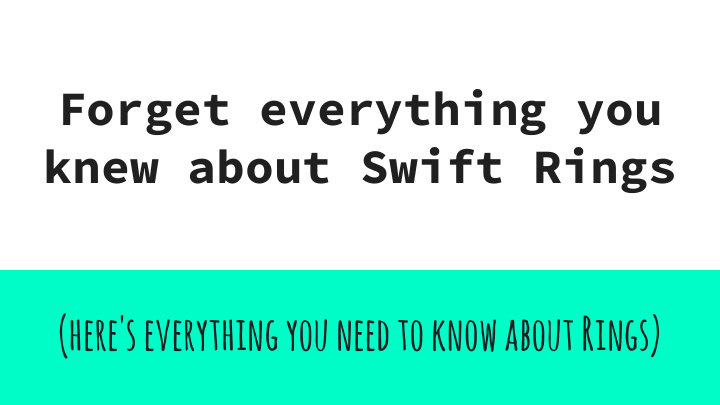



Forget everything you knew about Swift Rings (here's everything you need to know about Rings)
Your Ring Professors ● Christian Schwede ○ Principal Engineer @ Red Hat ○ Stand up guy ● Clay Gerrard ○ Programmer @ SwiftStack ○ Loud & annoying
Rings 201 How to use Rings ● Why Rings Matter ● Ninja SWIFT RING Tricks ● What are Rings ● MOAR Awesome Stuff ● How Rings Work ●
Swift 101 Looking for more general intro to Swift? ● Swift 101: https://youtu.be/vAEU0Ld-GIU ● Building webapps with Swift: https://youtu.be/4bhdqtLLCiM ● Stuff to read: https://www.swiftstack.com/docs/introductio n/openstack_swift.html
One Ring To Rule Them All
Swift Operators Devops Can be a wild ride Ring Masters
Ring Features ● DEVICES & SERVERS ● ZONES ● Regions ○ Multi-Region ○ Cross-Region ○ Local-Region ● Storage POLICIES
Swift’s Rings use Simple Concepts Consistent Hashing introduced by Karger et al. at MIT in 1997 The Same Year HTTP/1.1 is specified in RFC 2616
Consistent what? Just remember the ● 27601 94104 distribution function modulo 2 No growing lookup tables! ● Easy to distribute! ● 0 1
Partitions in Swift Object namespace is mapped to a number of partitions ● Each partitions holds one or more objects ● hash Dir Part Dir hashed objectname timestamp partition /srv/node/sdd/objects/9193/488/1c...88/1476361774.53303.data Suffix Dir Last 3 chars from hashed objectname
S w replica2part2dev_id i f t ’ s A d D r e s s B o o k Replica # 1 Replica # 2 Replica # 3 Part # 0 Device # 0 Device # 1 Device # 3 Part # 1 Device # 3 Device # 0 Device # 1 Part # 2 Device # 3 Device # 4 Device # 2 Part # 3 Device # 2 Device # 0 Device # 1 Part # 4 Device # 1 Device # 4 Device # 3 Part # 5 Device # 0 Device # 2 Device # 4 Part # ... ... ... ...
How to lookup partition Primary get_nodes(part) Part # 2 Device # 3 Device # 4 Device # 2 Handoff get_more_nodes(part)
What makes a good ring A good ring has good ● Dispersion ● Balance (some, but not too much!) ● Low overload PC LOAD LETTER Reassigned 215 (83.98%) partitions. Balance is now 11.35. Dispersion is now 83.98
Fundamental Constraints A Failure Domain ● Devices (disks) FAILS TOGETHER ● Servers ● Zones (racks) ● Regions (datacenters) These are tiers
Dispersion Measurement that the Failure Domain of each Replica of a Part is unique as possible
Fundamental Constraints balance
The Rebalance Process "rings are not pixie dust that magic data off of hard drives" -- darrell
Rebalance Introduces a Fault!
Fundamental Constraints min_part_hours Only move one replica of a partition per rebalance
Monitoring Replication Cycle ● Only rebalance after a full replication cycle ● swift-disperSion-report is your friend Queried 8192 objects for dispersion reporting, ... There were 3190 partitions missing 0 copy. There were 5002 partitions missing 1 copy. 79.65% of object copies found (19574 of 24576)
Patitions Assigned GB used STARTING TO FILL!
First Cycle Ring Push Primary Partitions Finished Handoff Partitions
OVERLOAD
Balance vs. Dispersion FIGHT!
The decimal fraction of one replicas worth of partitions 1 . REPLICANTHS 5
3 Replicas = .6 5 “units”
.6 + .6 + .6 ~1 Replica + 1 = 2.8
} ~1 Replica 2 Replicas .6 => .66 ~ 11%
Overload Too Much => DRIVES FILL UP Not Enough => CORRELATED DISASTER (Hopefully it was cat pics?) Just use 10% … it’ll probably be fine
Partition POWER
Balancing the unknowns How to distribute objects of unknown size well-balanced? ● Objects vary between 0 bytes and 5 GiB in size ○ => Store more than one partition per disk ● => Aggregation of random sizes balances out ●
Disk fill level vs. partition count Max A v g M i n
Choosing partition power Number of partition is fixed ● More disks => less partitions per disk ● Choose a part power with a ~ thousand partitions per disk ● Based on today's need, not an imaginary future growth ○ It is highly unlikely that your partition power is >> 20, ● and definitely not 32 https://gist.github.com/clayg/6879840
You became an unicorn Skyrocketing growth? Congrats! ● We’re working on increasing ● partition power for you to keep your cluster balanced https://review.openstack.org/#/c/337297/ clipartlord.com Decreasing won’t be possible - ● at least not without a serious downtime
Wrapping Up
What’s a good cluster? Partpower 14 -> 2^14 = 16384 2 n d 16384 partitions * 3 replicas / 32 disks = d a t a c r e e t n n e c t a t a e d r n i a M 1536 parts per disk Region 1 Region 2 Disk weight Zone 1 Zone 2 8 x 8 x 6 x (64+64+60) / 3 = 62.66 4000 4000 5000 One RACK + Switch Overload: 4.5% 8 x 8 x 6 x 4000 4000 5000 Dispersion: 0 64 TB 60 TB Balance: 4.65
Questions? Thanks! clay@swiftstack.com cschwede@redhat.com
Recommend
More recommend